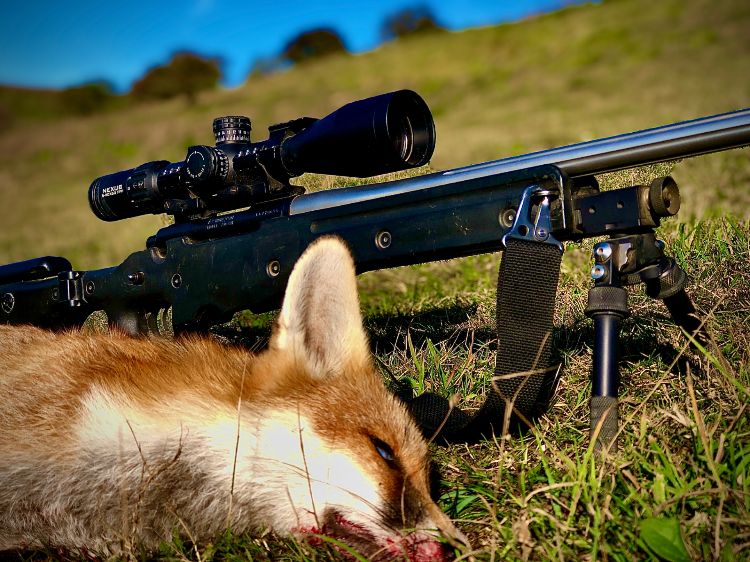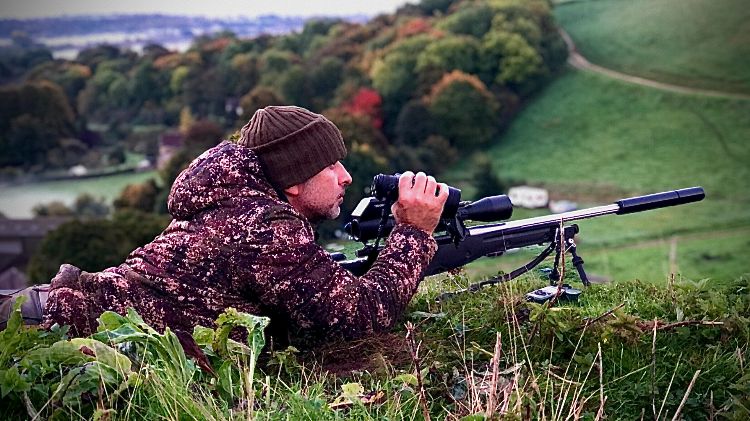A flicker of gingery red caught my eye amongst the otherwise still flock. The sun had just begun to peek over the brow of the hill, it’s warming glow creeping slowly through the grass and haloing the ewes hunched together on the slope. A skylark rose and fell in the air, its charming melody only broken by the occasional cry of a young lamb to its mother.
I watched as the fox systematically checked each ewe as it passed through the flock, searching for a vulnerable youngster. One or two of the braver mothers stood boldly as the predator passed a little too close, a firm stamp of a hoof enforcing a message that she would fight to protect her offspring.
I eased the rifle tighter into my shoulder and tucked my fist under the butt of the stock, biding my time.
The fox was still several hundred yards from me, and although I was confident I could make the shot, there was no need just yet – it was working its way in my direction. I wanted to be certain of this shot as this, I felt sure, was the fox I had been waiting for, the same fox that had already preyed on three of the young lambs over the past week.
With so many lambs born on the vast open downland, losses to foxes are inevitable, but once a fox gets a taste for this easy food source, those losses can quickly have a substantial financial impact on the farm.
Much of the time, foxes are simply drawn in by the smell of blood and afterbirth, as well as perhaps the feeble cries of the young lambs. Naturally, to a fox feeding on afterbirth, a newly born lamb or stillborn covered in the same, will seem little different if it is left unguarded by its mother, and thus a problem fox is created.
With foxes themselves under pressure during the spring to feed their own young, they will become particularly bold and regularly cash in on the easy food source day and night.
I’d already spent the two previous nights sat out in the dark to no avail for this fox, only for it to take another lamb by the time the farmer came looking the next morning.
The first evening, I’d shot a large dog fox in the bottom of the valley and had thought that success had come early, frustratingly only to see the losses continue.
The fox closed to within 200 yards before suddenly veering away from the flock toward a nearby patch of gorse. Scanning ahead of the animal I spotted for the first time what had caught its attention. A young singleton hunched close to the cover almost out of sight, neglected by its mother or simply separated during the night.
The lamb stood on stiff legs and began to cry at the approaching fox, unaware that it was in fact enticing the fox in further.
The fox by now, if it wasn’t before, was clearly closing in on the lamb and at only 10 yards or so from it began to circle cautiously around it before stopping to sit and wait for a moment.
 This was the opportunity I needed and sinking my cheek into the stock, my eyes quickly checked the scope’s turrets were correctly set and the little scope level was showing the reticle was perfectly upright – not that it would make a massive difference at this range, but it was part of my checklist for every shot with this rifle.
This was the opportunity I needed and sinking my cheek into the stock, my eyes quickly checked the scope’s turrets were correctly set and the little scope level was showing the reticle was perfectly upright – not that it would make a massive difference at this range, but it was part of my checklist for every shot with this rifle.
My index finger eased the Remington’s safety catch forward with a soft click and I leant forward on the bipod to help stop it skipping upwards with the recoil.
I edged the rifle round until the fox was in my scope and I centred the reticle on the fox’s shoulder. The fox sat staring intently at the lamb as my finger increased the pressure on the trigger until it reached its 1.5lb pound breaking point, and the morning’s tranquility was shattered by an unnatural crack.
In a split second, 143gr of bad news was travelling at around 2,800 feet per second on its way to spoil the fox’s morning, and a fraction of a second later the little vixen lay dead in the grass.
Surprisingly, on inspection, this turned out to be a barren vixen and therefore unlikely to be feeding cubs, although occasionally other family members will assist another vixen to feed her cubs.
 Call to action
Call to action
Like all fox controllers up and down the country working sheep farms, the lambing season is by far the busiest time of the year with farmers quickly on the phone with the first glimpse of a fox, and throughout April (the first of April being the traditional start of the lambing season locally) I will often be out most nights of the week over several farms.
As a rule, I control foxes all year round on many of these farms, yet I also shoot over a couple of them just before the lambing starts which makes it difficult to effectively reduce the fox population in that area, before I’m needed elsewhere!
Another busy time for me can be shortly before the game birds arrive on the couple of farms that I look after that also hold pheasant shoots. Young poults are renowned for not being particularly bright and can quickly find themselves hoovered up by a crafty fox before they have had the chance to ‘wise up’.
Of course, it’s not just game birds; poultry and livestock can fall victim to a fox. They will also take quite a toll on the songbird population too, by devouring any small living thing as well as the eggs of any ground-nesting birds they find.
 Opportunity knocks
Opportunity knocks
Foxes are natural opportunists and will always take an easy option if they can or if they are bold enough. Attacks on poultry often peak in the summer when the year’s cubs begin to venture out to hunt for themselves. Due to their size, they will often get into places perhaps a fully grown fox couldn’t fit, and their teenage boldness will often land them in some sticky situations.
To find a cub stuck inside a chicken run or even Larsen trap is not uncommon, and invariably doesn’t end well for the young tearaways.
This boldness leads to natural selection, and many cubs will die on the roads or walk in front of a gun, leaving those that do survive the initial harsh life lessons a little wiser.
Harvest is often a time when many farmers, keepers and foxers will head out to thin out fox numbers, once all the crops are off the fields. At this time of year, the ground should be drivable and shooting young, uneducated foxes on the stubble is easy work so a good number of foxes can be accounted for by an experienced fox shooter.
One needs to be careful not to make too many mistakes though, as although these young foxes can be quite foolhardy, they very quickly learn to uphold the sacred tradition of being as crafty as a fox. `